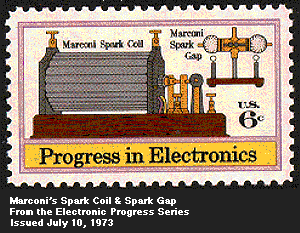| Mass Communication Media on Stamps The Wireless Telegraph |
|
|---|---|

Technology advanced rapidly from the mid-1800s. Samuel F.B. Morse demonstrated a wired Morse-code telegraph machine in 1844. The telephone could send a voice through a wire in 1876. German scientist Heinrich Hertz, in 1887, demonstrated the existence of radio waves which traveled at the speed of light. In 1895, the Italian inventor Guglielmo Marconi read about those Hertzian waves and devised a machine to send Morse code over radio waves instead of through a wire. Eventually he got backing for his invention and in 1901 built a powerful transmitter to send a message across the Atlantic Ocean – without wires. He also figured out by 1904 how to "tune" a transmitter to a specific wavelength or frequency. This cut down on interference from other signals on other frequencies. The new wireless communication could be used by ships at sea. Remote stations could receive broadcasts. However, the equipment at that time was large and heavy. Because Marconi had experiemented with long waves instead of short waves, the equipment required big antennas and more power to transmit. Later, the radiotelephone sent a voice through the air in 1906. The radio came into household use in the 1920s. |
|
American Philatelic Society member SpaceToday.org.

| Navigating this Virtual Stamp Album | |
|---|---|
| | TOP OF THIS PAGE | | PRINTING | BOOKS | NEWSPAPERS | PAMPHLETS | MAGAZINES | | TELEGRAPH | WIRELESS | RADIO | TELEVISION | | MOVIES | RECORDINGS | THE WORLD WIDE WEB | | STAMP ALBUM FRONT PAGE | |  To the Webmaster's page |